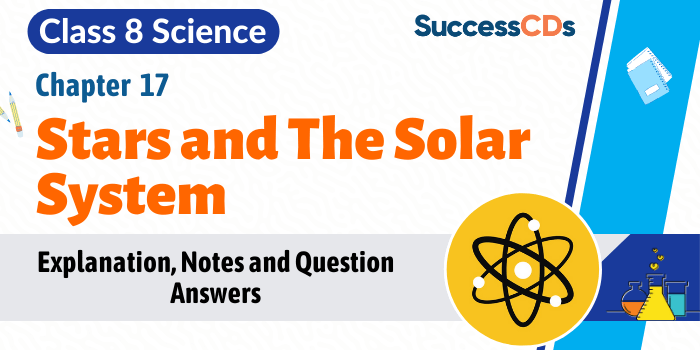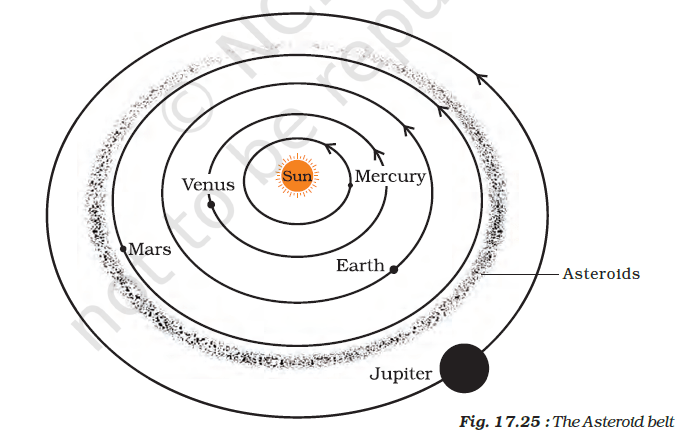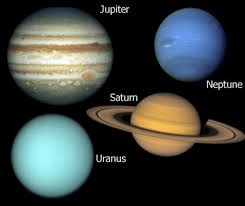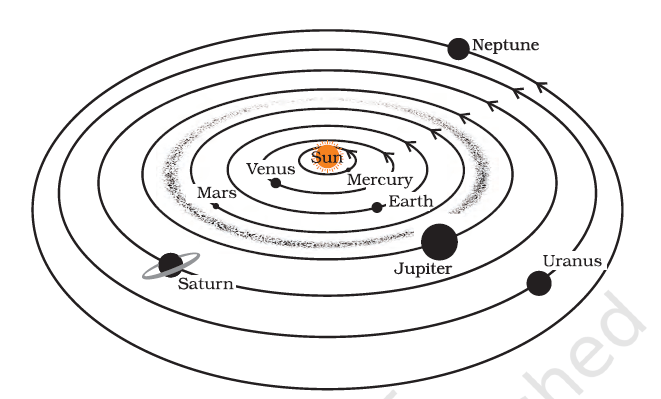Stars and the Solar System Class 8 Science Chapter 17 – Explanation, Notes, Question Answers
Stars and the Solar System Class 8 Science Chapter 17 as per NCERT Book used in CBSE and other Schools. The lesson covers the complete explanation of class 8 Chapter 17 Stars and the Solar System. Topics covered are celestial objects, Sun, comets, astronomy, planets, meteors and meteorites, moon, satellites, meteor shower, stars, Astronomy in ancient India, artificial satellites, constellation, Mangalyaan, NCERT book solutions, Earth, asteroids. The lesson covers all important questions and NCERT solutions to book questions have also been provided for the convenience of the students.
Class-8 Science Chapter-17
Stars and the Solar System
- celestial objects
- Sun
- comets
- astronomy
- planets
- meteors and meteorites
- moon
- satellites
- meteor shower
- stars
- Astronomy in ancient India
- artificial satellites
- constellation
- Mangalyaan
- NCERT book solutions
- Earth
- asteroids
Topics to be covered in this chapter are:
- Celestial Objects
- Astronomy
- Moon
- Stars
- Constellation
- Earth
- Sun
- Planets
- Satellites
- Astronomy in ancient India
- Mangalyan
- Asteroids
- Comets
- Meteors and meteorites
- Meteor shower
- Artificial Satellites
Introduction
As we all know that we live on earth. We all know that earth is a planet and planets are a part of the solar system.
So, just like earth there are many planets in the solar system. For example – Mercury, Venus, Earth, Mars, Jupiter, Saturn, Uranus and Pluto. Apart from this we have satellites also for example moon. Moon is a natural satellite. So we will study this in detail.
Stars and the Solar System Class 8 Video Explanation
Top
So, whatever heavenly bodies we see in the sky are known as celestial objects. In ancient times people used to think that the celestial objects are basically the gods we worship. But with the development of science and technology, the people come to know that these are the celestial objects.
Top
The science which deals with the study of the celestial objects is known as astronomy. The one who study this science is known as an astronaut.
The study of celestial objects and associated phenomenon is called as astronomy. The astronauts use telescope for studying the celestial objects.
As our sky is far away from us and so are the celestial objects. So, in order to study these distant objects we use telescope.
As we know that planets revolve around the sun in an orbit. Similarly the satellite is that object which revolves around a planet in an orbit. So, moon is known as satellite as it revolves around the earth. So now we will study about moon in detail
Moon
Phases of the moon
The various shapes of the bright part of the moon as seen during the month. They are known as the phases of moon. Moon is a non luminous body.
This means that the moon does not have its own light. But it shines. It shines because it reflects the light falling on it from the sun. If you observe the moon with naked eye, you see dark patches on it. These dark patches present on moon indicate the mountains on the moon.
An American astronaut named Neil Armstrong and Aldrin who landed on moon with the help of a vehicle named Apollo 11 in July 1969. The two scientists noted down that the surface of the moon is a rocky desert. There was no water or vegetation present on the surface of moon. It was a rocky desert. That is why life is not possible on moon and only 1/6th of gravitational pull that we have on earth is present on moon. If we talk about the temperature of moon during day time it is 100 degree Celsius and in night it is 168 degree Celsius because of such inhabitable conditions. Life is not present on moon.
Now, if we talk about the phases of moon, we have noticed this that the shape of the moon keeps on changing. Someday it is big and the other day it is small, this is because the moon is a non luminous body. The shape which we see is that part of the moon on which the sunlight falls. That is why we see moon in different phases as it reflects only that much light which it receives from the sun.
The day on which moon receives full light from the sun it reflects full, resulting into a full shape. This day is called full moon day. Likewise the day when it is fully dark as the light does not fall on moon then that day is called new moon day. The days when moon is partly visible means when there is some light falling on the moon and it is partly visible that day is known as crescent day.
The Full Moon day
When the whole disc of moon facing towards the earth is visible to us. It is known as the full moon day. It generally occurs on the 14th day.
Crescent moon
The next day of the new moon day, when only a small portion of the moon is visible in the sky. This is known as the crescent moon.
So, we can say that the phases of moon play an important role in our life because almost all festivals in India are celebrated according to the phases of the moon.
Diwali is celebrated on the new moon day, Budh Poornima and Guru Nanak’s birthday are celebrated on full moon day, Maha Shivratri is celebrated on thirteenth night of waning moon, Eid -ul- Fitr is observed on the day following the sighting of crescent moon.
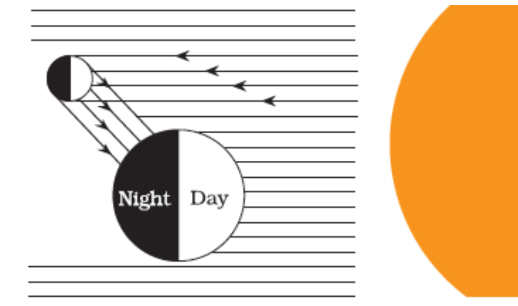 Q. Why phases of the moon occur?
Q. Why phases of the moon occur?
A. The moon does not produce its own light, whereas the Sun and other stars do. We see the moon because the sunlight falling on it gets reflected towards us. We, therefore, see only that part of the moon, from which the light of the Sun is reflected towards us.
Position of the moon in its orbit and its corresponding phases.
As we have read, the various stages such as the stage when the moon is not visible, it is called new moon day. Then comes the crescent stage and then the full moon day.
The moon revolves around the earth and the earth revolves around the sun. So, we can say that in an indirect form both moon and the earth revolve around the sun.
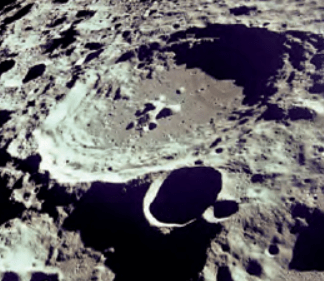
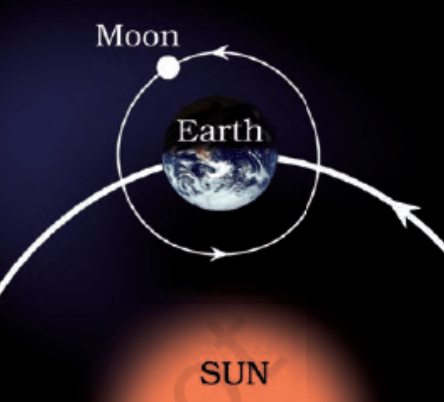 Now if we talk about the surface of the moon. The moon’s surface is dusty and barren. There are many craters of different sizes. It also has a large number of steep and high mountains. Some of these are as high as the highest mountains on the Earth. The moon has no atmosphere. It has no water. Therefore, no life exists on the moon.
Now if we talk about the surface of the moon. The moon’s surface is dusty and barren. There are many craters of different sizes. It also has a large number of steep and high mountains. Some of these are as high as the highest mountains on the Earth. The moon has no atmosphere. It has no water. Therefore, no life exists on the moon.
Stars
So, let’s discuss about the stars. When its day what we can see in the sky is the sun but as the night comes, we start seeing some objects which twinkle. So, those twinkling bodies are stars.
Star is a luminous body because it can emit its own light.
The size of star is bigger than that of earth. Some of the stars are even bigger than sun. As they are far away from us, hence, they look so tiny. We can see them in night only because during day, the light of the sun is so intense that it becomes difficult to see them. Likewise we have some star like objects present in our sky which do not twinkle but they keep on shining. They are known as planets. But before we study about the planets we will first talk about stars.
The sun which is also a star is 150,000,000 kilometers (150 million km) away from the Earth. The next nearest star is Alpha Centauri. It is at a distance of about 40,000,000,000,000 km from the Earth
As it is not easy to express such a long distance in Kilometers, so the unit used to express the distance between the objects of universe is ‘light year’.
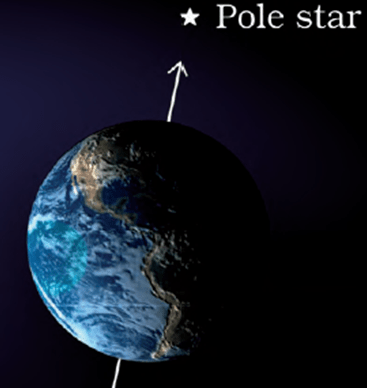 How we define light year?
How we define light year?
It is the distance travelled by light in one year.
So, the next question is why does the sun appear to rise in the east and set in the west?
The answer is that as the earth rotates from west to east on its axis, so, the Sun appears to rise in the east and set in the west.
We have a star named Pole star. It is also called a stationary star because it does not move and it is the brightest star. It is situated on the axis of earth that is why it appears immovable.
Sometimes we see a cluster of stars which we can relate with the shape of other things. This group of stars is known as a Constellation.
Constellations
The stars forming a group that has a recognizable shape is called a constellation. The shapes of constellations resemble objects familiar to those people.
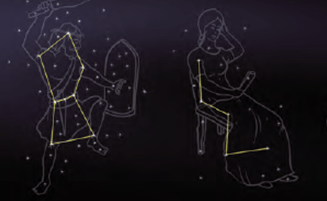 Ursa Major
Ursa Major
One of the most famous constellations which you can see during summer time, in the early part of the night is Ursa Major. It is also known as the Big Dipper, the Great Bear or the Saptarshi. There are seven prominent stars in this constellation. It appears like a big ladle or a question mark. There are three stars in the handle of the ladle and four in its bowl.
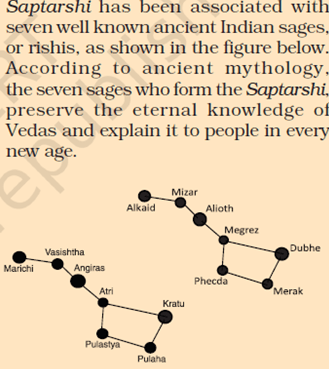
Another constellation which we have is Orion
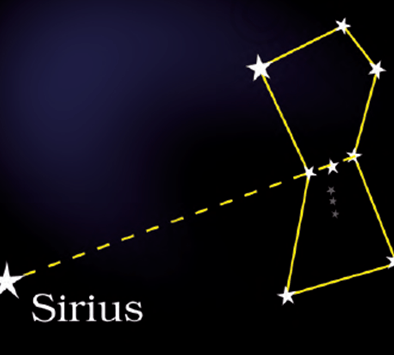 Orion
Orion
Orion can be seen during winter season in the late evenings. It also has seven or eight bright Stars. Orion is also called the Hunter. The three middle stars represent the belt of the hunter. The four bright stars appear to be arranged in the form of a quadrilateral.
The star Sirius, which is the brightest star in the sky, is located close to Orion.
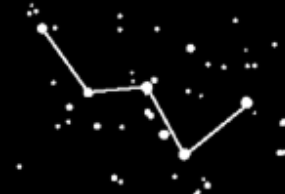 Cassiopeia
Cassiopeia
Cassiopeia is another prominent constellation in the northern sky. It is visible during winters in the early part of the night. It looks like a distorted letter W or M.
So, now as we know about the various celestial bodies. Now we will talk about the solar system
The solar system
The Sun and the celestial bodies which revolve around it form the solar system. It consists of large number of bodies such as planets, comets, asteroids and meteors.
 The Earth
The Earth
The Earth, as you know, also revolves around the Sun. It is a member of the solar system. It is a planet. There are seven other planets that revolve around the Sun. The tilting of earth on its axis and its revolving around the sun causes seasonal changes on earth.
The eight planets in their order of distance from the Sun are
- Mercury,
- Venus,
- Earth,
- Mars,
- Jupiter,
- Saturn,
- Uranus and
- Neptune.
 Sun
Sun
The Sun is the nearest star from us. It is continuously emitting huge amounts of heat and light. The Sun is the source of almost all energy on the Earth. In fact, the Sun is the main source of heat and light for all the planets.
 Planets
Planets
The planets look like stars, but they do not have light of their own.
The simplest method of differentiating planets from stars is that stars twinkle, whereas planets do not.
Besides revolving around the Sun, a planet also rotates on its own axis like a top. The time taken by a planet to complete one rotation is called its period of rotation. Some planets are known to have moons/satellites revolving round them.
Satellites
Any celestial body revolving around another celestial body is called its satellite. Moon is a satellite of the Earth. There are many man-made satellites revolving round the Earth. These are called artificial satellites.
Astronomy in ancient India
The practice of astronomy in ancient India is mentioned in Rig Veda which was composed about 4000 years ago.
The work of Aryabhata on astronomy can be found in his writing ‘Aryabhatiya’.
When the shadow of the Earth falls on the moon, it causes lunar eclipse. When the shadow of the moon falls on the Earth, it causes solar eclipse.
Aryabhata also found the distance between the Earth and the moon, which is very close to the known value today.
 So, now we will study about the planets in detail-
So, now we will study about the planets in detail-
Mercury
The planet mercury is nearest to the Sun. It is the smallest planet of our solar system. Because Mercury is very close to the Sun, it is very difficult to observe it, It has no satellites.
Venus
Venus is earths nearest planetary neighbour. It is the brightest planet in the night sky. Sometimes Venus appears in the eastern sky before sunrise. Sometimes it appears in the western sky just after sunset. Therefore it is often called a morning or an evening star, although it is not a star.

Earth
The Earth is the only planet in the solar system on which life is known to exist. It has one moon. From space, the Earth appears blue – green due to the reflection of light from water and landmass on its surface.
The axis of rotation of the Earth is not perpendicular to the plane of its orbit. The tilt is responsible for the change of seasons on the Earth.
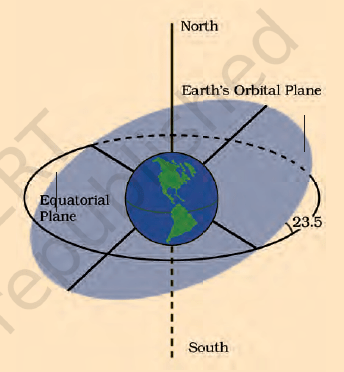 Environmental conditions responsible for the existence of life on the earth
Environmental conditions responsible for the existence of life on the earth
These include-
- just the right distance from the Sun so that it has the right temperature range,
- the presence of water,
- Suitable atmosphere
- a blanket of ozone.
 Mars
Mars
The next planet, the first outside the orbit of the Earth is Mars. It appears slightly reddish and, therefore, it is also called the red planet. Mars has two small natural satellites.
Mangalyaan
Indian Space Research Organization (ISRO) launched India’s first Mars orbiter mission – Mangalyaan, on November 5, 2013. It was successfully placed into an orbit of Mars on September 24, 2014. With this India became the first country in the world to do so in its first attempt.
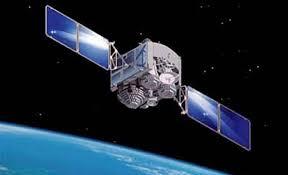
Jupiter
Jupiter is the largest planet of the solar system. It is so large that about 1300 earths can be placed inside this giant planet. However, the mass of Jupiter is about 318 times that of our Earth.

Saturn
Beyond Jupiter is Saturn which appears yellowish in color. What make it unique in the solar system is its beautiful rings. These rings are not visible with the naked eye. You can observe them with a small telescope.
Saturn also has a large number of satellites. One interesting thing about Saturn is that it is the least dense among all the planets. Its density is less than that of water.

Uranus and Neptune

These are the outermost planets of the solar system. They can be seen only with the help of large telescopes. Like Venus, Uranus also rotates from east to west.
The most remarkable feature of Uranus is that it has highly tilted rotational axis. As a result, in its orbital motion it appears to roll on its side.
Inner Planets
The first four planets, Mercury, Venus, Earth and Mars are much nearer the Sun than the other four planets. They are called the inner planets. The inner planets have very few moons.
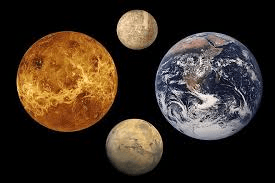
Outer Planets
The planets outside the orbit of Mars, namely Jupiter, Saturn, Uranus and Neptune are much farther off than the inner planets. They are called the outer planets. They have a ring system around them. The outer planets have large number of moons.
Asteroid
There is a large gap in between the orbits of Mars and Jupiter. This gap is occupied by a large number of small objects that revolve around the Sun. These are called asteroids. Asteroids can only be seen through large telescopes.
Comets
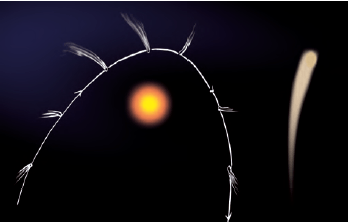 Comets are also members of our solar system. They revolve around the Sun in highly elliptical orbits. However, their period of revolution around the Sun is usually very long. A Comet appears generally as a bright head with a long tail.
Comets are also members of our solar system. They revolve around the Sun in highly elliptical orbits. However, their period of revolution around the Sun is usually very long. A Comet appears generally as a bright head with a long tail.
The length of the tail grows in size as it approaches the sun. The tail of a comet is always directed away from the Sun. Many comets are known to appear periodically. One such comet is Halley’s Comet, which appears after nearly every 76 years. It was last seen in 1986.
Meteors and Meteorites
Bright streaks of light in the sky, these are commonly known as shooting stars, although they are not stars. They are called meteors. A meteor is usually a small object that occasionally enters the earth’s atmosphere. At that time it has a very high speed. The friction due to the atmosphere heats it up. It glows and evaporates quickly.
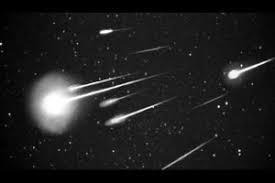
Meteorites
Some meteors are large and so they can reach the Earth before they evaporate completely. The body that reaches the Earth is called a meteorite.
Meteorites help scientists in investigating the nature of the material from which the solar system was formed.
Meteor Shower
When the Earth crosses the tail of a comet, swarms of meteors are seen. These are known as meteor showers. Some meteor showers occur at regular intervals each year.
Artificial Satellites
Artificial satellites are man-made. They are launched from the Earth. They revolve around the Earth much closer than earth’s natural satellite, the moon.
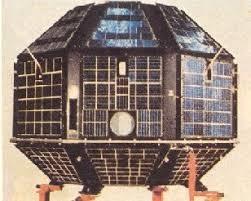 Artificial satellites have many practical applications.
Artificial satellites have many practical applications.
They are used for-
- forecasting weather
- Transmitting
- television and radio signals
- telecommunication
- remote sensing
India has built and launched several artificial satellites.
Aryabhata was the first Indian satellite. Some other Indian satellites are INSAT, IRS, Kalpana-1, EDUSAT, etc.
NCERT Book Solutions
Question/ Answers
Question 1:
Which of the following is NOT a member of the solar system?
(a) An asteroid
(b) A satellite
(c) A constellation
(d) A comet
Answer:
(c) Constellation
A constellation is not a member of the solar system. Constellations are groups of stars that form recognisable shapes.
Question 2:
Which of the following is NOT a planet of the sun?
(a) Sirius
(b) Mercury
(c) Saturn
(d) Earth
Answer:
(a) Sirius
Sirius is a star and not a planet of the sun.
Question 3:
Phases of the moon occur because
(a) we can see only that part of the moon which reflects light towards us.
(b) our distance from the moon keeps changing.
(c) the shadow of the Earth covers only a part of the moon’s surface.
(d) the thickness of the moon’s atmosphere is not constant.
Answer:
(a) Phases of the moon occur because we can see only that part of the moon which reflects light towards us.
Moon does not produce its own light. We are able to see the moon because the sunlight falling on it gets reflected towards us. Thus, we see only that part of the moon from which the light of the sun gets reflected towards us.
Question 4:
Fill in the blanks:
(a) The planet which is farthest from the sun is _________.
(b) The planet which appears reddish in colour is _________.
(c) A group of stars that appear to form a pattern in the sky is known as a __ _________.
(d) A celestial body that revolves around a planet is known as a _________.
(e) Shooting stars are actually not _________.
(f) Asteroids are found between the orbits of ________ __ and _________.
Answer:
(a) The planet which is farthest from the sun is Neptune.
(b) The planet which appears reddish in colour is Mars.
(c) A group of stars that appear to form a pattern in the sky is known as a constellation.
(d) A celestial body that revolves around a planet is known as a satellite.
(e) Shooting stars are actually not stars.
(Shooting stars are not stars, they are meteors)
(f) Asteroids are found between the orbits of Mars and Jupiter.
(Asteroids occupy a large gap between the orbits of Mars and Jupiter)
Question 5:
Mark the following statement as true (T) or false (F).
(a) Pole star is a member of the solar system. ( )
(b) Mercury is the smallest planet of the solar system. ( )
(c) Uranus is the farthest planet in the solar system. ( )
(d) INSAT is an artificial satellite. ( )
(e) There are nine planets in the solar system. ( )
(f) Constellation Orion can be seen only with a telescope. ( )
Answer:
(a) False
Stars are not a member of the solar system. The sun and the celestial bodies
revolving around it form the solar system.
(b) True
Mercury is the smallest planet of the solar system.
(c) False
Neptune is the farthest planet in the solar system.
(d) True
INSAT is an artificial satellite.
(e) False
There are eight planets in the solar system.
They are Mercury, Venus, Earth, Mars, Jupiter, Saturn, Uranus and Neptune.
(f) False
Constellation Orion can be seen during winters around late evenings. It is one of the most magnificent constellations in the sky, visible to the naked eyes.
Question 6
Match items in column A with one or more items in column B.
| A | B |
| (i) Inner planets | (a) Saturn |
| (ii) Outer planets | (b) Pole star |
| (iii) Constellation | (c)Great Bear |
| (iv) Satellite of the Earth | (d) Moon |
| (e) Earth | |
| (f) Orion | |
| (g) Mars |
Solution 6
| A | B |
| (i) Inner planets | (g), (e) Mars, Earth |
| (ii) Outer planets | (a) Saturn |
| (iii) Constellation | (c), (f) Great Bear, Orion |
| (iv) Satellite of the Earth | (d) Moon |
Question 7- In which part of the sky can you find Venus if it is visible in the sky?
Answer- Venus appears in the western sky just after sunset and is called the evening star.
Question 8- Name the largest Planet of the Solar system?
Answer- Jupiter is the largest planet.
Question 9- What is constellation? Name any two
Answer- A constellation is a group of star which forms a pattern that is recognizable. The two constellation are: Ursa major and orion.
Question 10- Name two objects other than planets which are members of the solar system?
Answer- The two objects other than planet are as follows:
- Meteor:They are the smallest objects which are seen as bright streak in the sky.
- Asteroid: They are small objects which revolve around the sun in the orbit of Mars.
Question 11- Explain how can you locate Pole star with the help of Ursa Major?
Answer- In order to locate the Pole star in the sky, first of all Ursa Major or Big Dipper constellation must be located. The bowl of the Big Dipper consists of four bright stars Consider two stars at the end of this bowl. Now, draw an imaginary straight line towards the Northern direction connecting these two stars (as shown in the given figure).This imaginary line meets a star called the Pole Star. The length of the imaginary line from the bowl is about five times the distance between the two stars of the bowl.
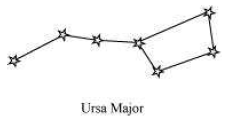
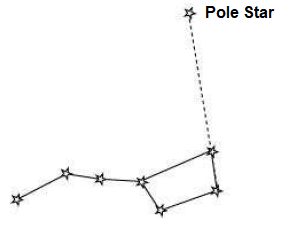
Question 12-Do you think that all the stars in the sky moves? Explain.
Answer: No, the earth rotates on its axis from west to east. Therefore, all the stars in the sky (except the pole star) seem to move from east to west. With reference to Earth, pole star in the sky does not seem to move because it is located above the axis of rotation of the Earth in the north direction. It seems to remain stationary at a point in the sky.
Question 13- Why is the distance between the stars expressed in Light year? Clearly, elaborate the statement the “The star is eight light years away from the earth”?
Answer: The distance of the star from the earth is very huge. It is troublesome to express these distance in kilometer (km). Therefore, these huge distances are expressed in light years. One light year is equal to the distance traveled by the light in one single year. A distance of the star from the Earth is eight light year. This means the distance between them is equal to the distance traveled by the light in eight years, i.e. distance of the star is 8 x (9.6 x 1012) = 7.6 x 1013 km away from Earth.
Question 14- The radius of Jupiter is 11 times bigger than the Earth. Calculate the ratio of the volumes of Jupiter and the Earth. So, how many Earth can fit the Jupiter?
Answer: Let’s consider Jupiter and Earth are two spheres with radii R and R’ respectively. Given in the question that radius of Jupiter is 11 times the radius of the Earth.
So, R’= 11R
Volume of sphere of radius r is given as = 43πr3
Volume of Earth = 43πr3
And, volume of Jupiter = 43π(R′)3=43π(11R)3=1331[43πR3]
The ratio of the volume of Jupiter and earth =volume of Jupiter volume of Earth =1331(43πR3)43πR3=1331
Therefore, this ratio suggests that Jupiter can fit 1331 number of Earth in it.
Image Source: NCERT
